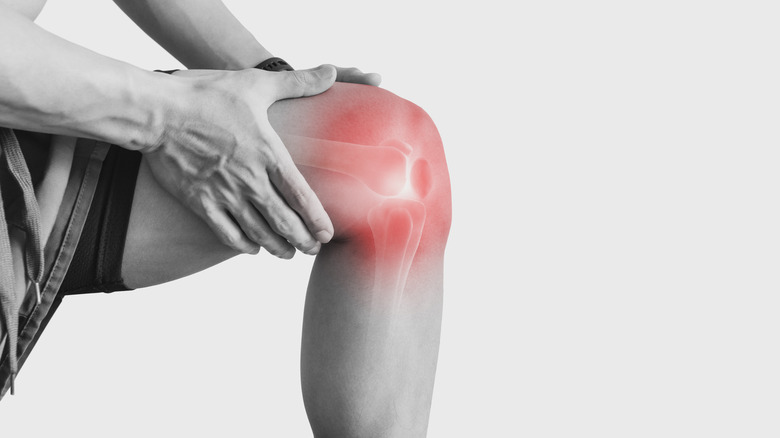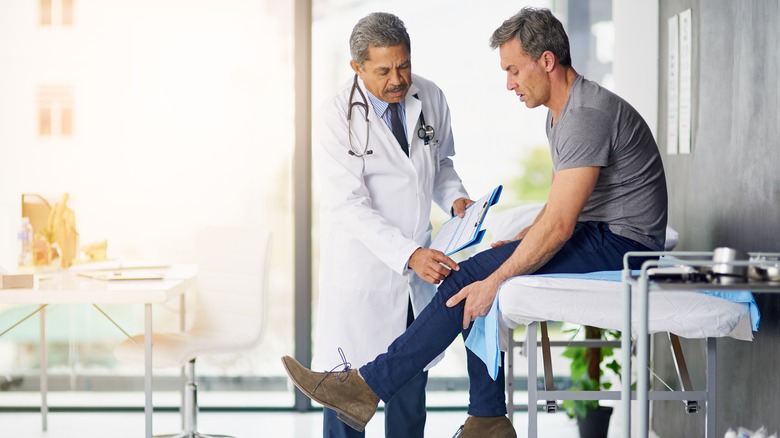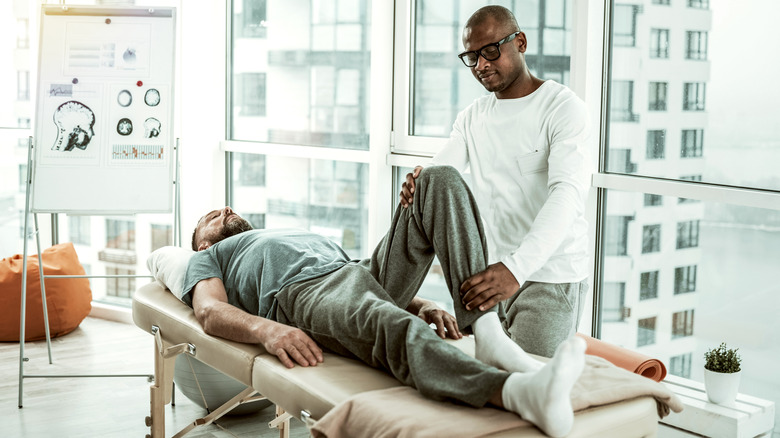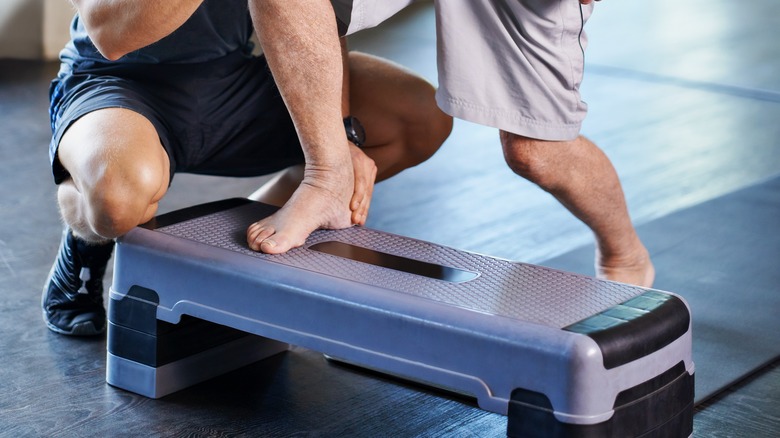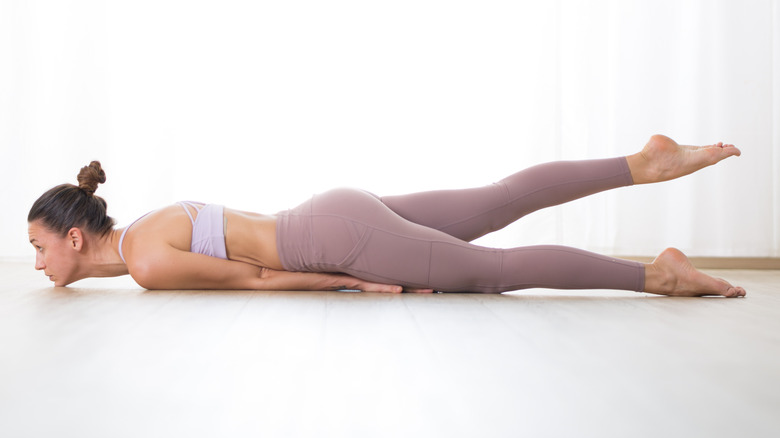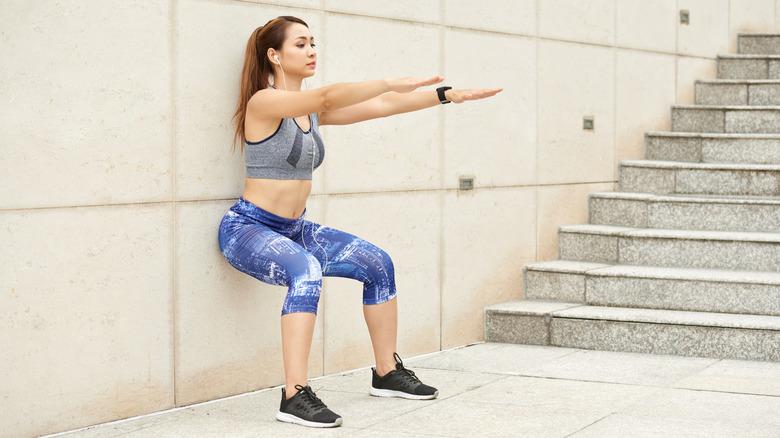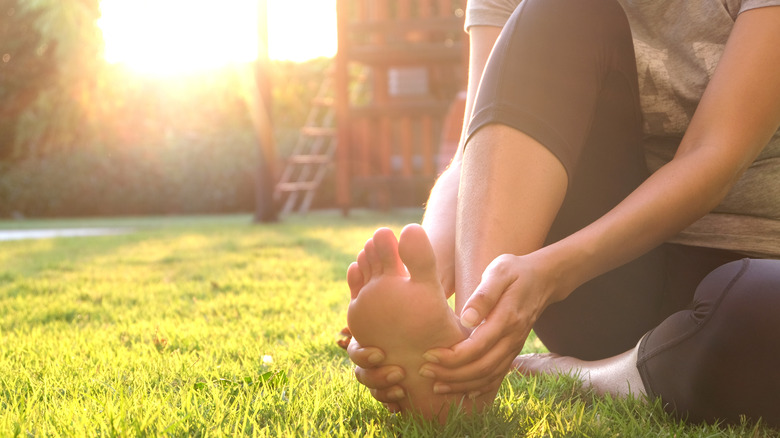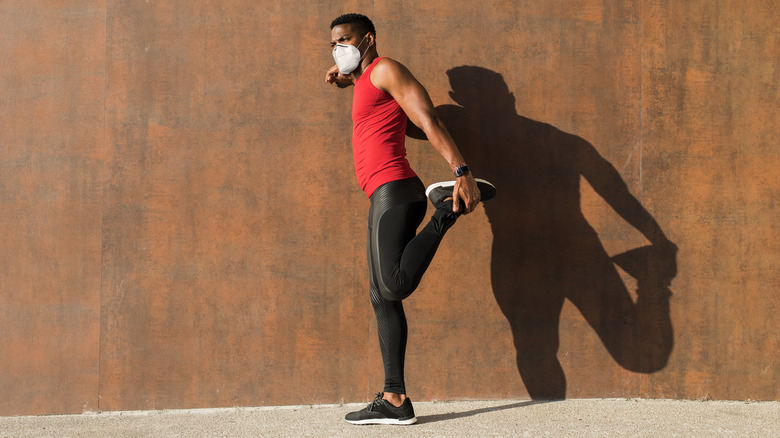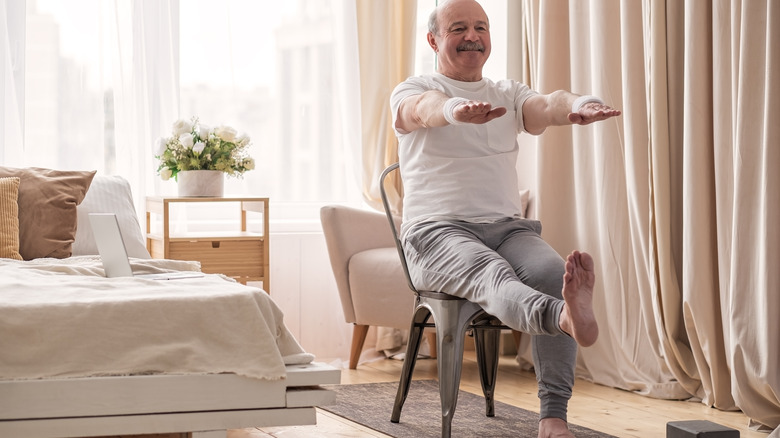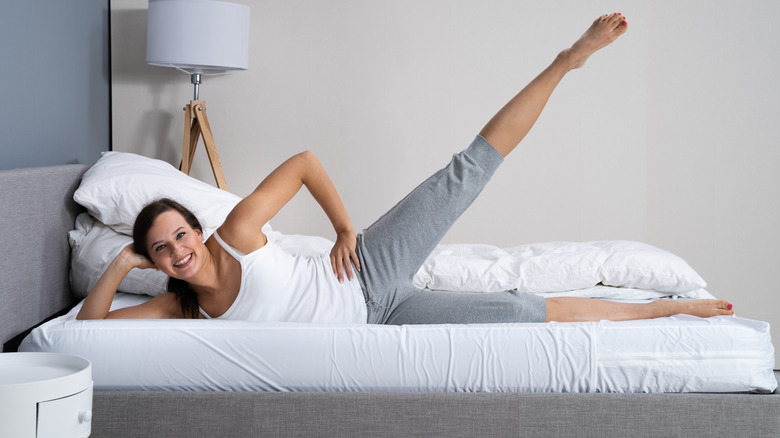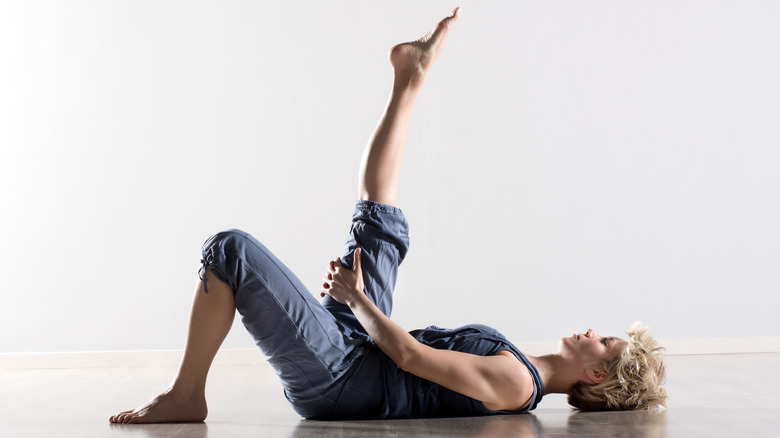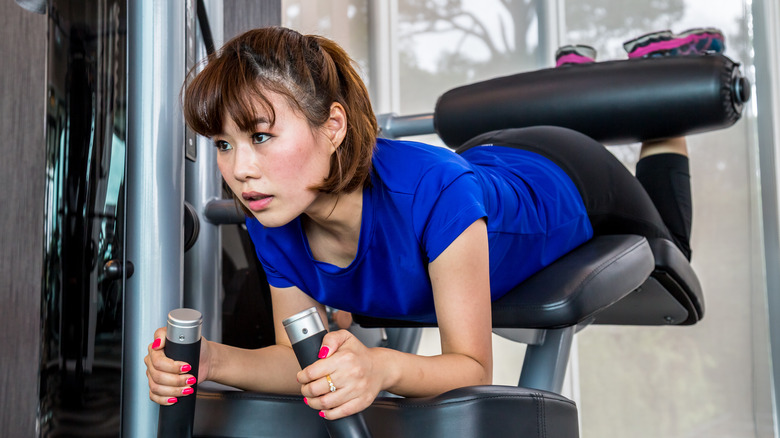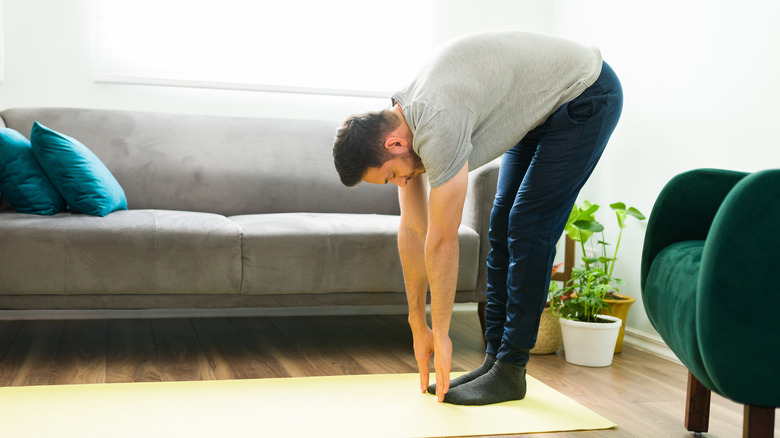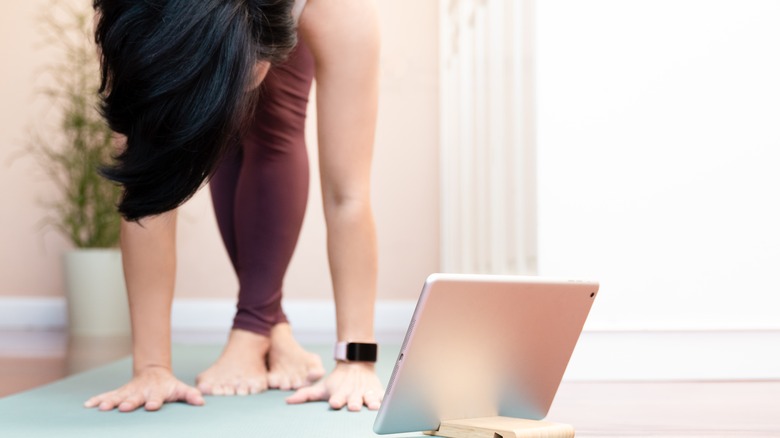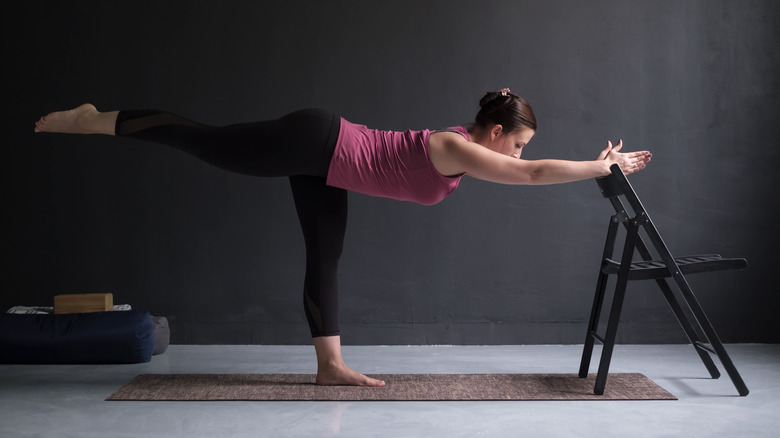The Best Exercises For Bad Knees
Let's face it — knee pain sucks. When one or both of your knees hurt, it can negatively affect your mobility and impact many of your daily activities. You might have to sit out on some of the things you love or even miss work. Knee pain is a very common issue that can affect anyone at any point in their life. It could be due to an injury, or other conditions such as arthritis or body mechanical problems (via Mayo Clinic). Certain risk factors increase your chances of developing knee pain, like being overweight, having old injuries that might flare up, participating in strenuous work or sports activities, or insufficient muscle flexibility or strength — which exercises and physical therapy can help with. Weak muscles are one of the main causes of knee pain and injury. Therefore, stretching and strengthening the muscles in your legs can be very beneficial for preventing and reducing pain.
While not all knee pain is dangerous, it's important to see a doctor if you have distinct knee swelling, can't stand, or feel like your knee is unstable. Other signs to get checked by a doctor include not being able to fully extend your leg, obvious deformities, fever, severe pain connected to an injury, or if the pain or swelling keeps getting worse.
How to do knee exercises safely
Before starting any exercise program for bad knees, it's important to check with your doctor to make sure that it's okay — especially if your knee pain is new. Your doctor can let you know more about what could be causing the pain, which exercises are best for you, and how to prevent further damage or injury (via WebMD). Your gut reaction to pain may be to rest and not use that body part, but too much rest can result in muscle weakness and atrophy. This is why exercising is key, but it's also important to consider the type of exercise you're doing. Avoid high-impact workouts that could lead to more pain, like running, jumping, dancing, or high-intensity sports. Also, steer clear of deep lunges and squats — these movements can put a lot of pressure on your knees and cause more injury if done incorrectly. Focus on gentle, easy stretching and strengthening exercises, like those listed below.
Also, remember RICE: rest, ice, compression, and elevation. Some rest is good, ice and compression from a knee brace or bandage can help reduce pain and swelling, and elevating your knee above your heart can help with swelling.
Straight leg raises
First of all, remember to do a little warm-up before jumping into any stretching or exercise program. Riding a stationary bike or going for a fast walk for several minutes should do the trick. This will help prepare your muscles for exercise and reduce the risk of further pain or injury (via WebMD).
This simple strengthening exercise is a great place to start any program for bad knees, since it puts very little tension on the joint. Straight leg raises will help stretch your quadriceps, which are located on the front of your thigh. Begin lying flat on your back on a comfortable surface. Bend one leg and place your foot on the ground or surface. Keeping your leg extended out straight, slowly start to raise your other leg, but do not exceed the height of your other knee. Then, gently lower back down. Only go as high as feels comfortable. If you can, repeat this movement 10 to 15 times, for three sets. If you have pain in both knees, make sure to repeat this movement on the other leg as well.
Step-ups
Begin a step-up exercise by standing on a step bench, platform, or the first step of a staircase (via WebMD). Take your weight off one foot and place it behind the step, then bend the knee of your standing leg and slowly lower down until you can lightly touch the toes of your loose foot on the ground. Then, stand back up and fully straighten your knee before beginning again. Make sure to keep your hips level for the entire movement. If this exercise feels too easy, you can make it harder by touching your heel on the ground instead of your toes, using a higher step, or raising the height of the bench or platform. Do this movement 10 to 15 times, then switch legs and repeat on the other side.
Physical therapist Jeanine Robotti of Physio Logic recommends starting with a 6-inch step, then gradually increasing the height — but not going higher then your knee. Try to keep your knee in line with your second toe as you move through this exercise.
Prone straight leg raises
Prone straight leg raises are similar to straight leg raises, but this exercise is performed lying on your belly (via WebMD). You may be more comfortable on top of a yoga mat or squishy surface, like a carpet or workout pad. Begin on your belly with your legs straight. Activate the muscles in your buttocks and one leg, then slowly begin to lift that leg up away from the ground and toward the sky. Try to hold it there for three to five seconds, then lower and repeat. Do your best to continue breathing and try not to hold your breath. Attempt 10 to 15 leg lifts on one side, then repeat with the other leg. Make sure you do not feel any back pain while performing this exercise — if you do, reduce the height of your leg lift until you don't experience pain. If the pain persists, discontinue this exercise and consult with your doctor. Over time, if this movement begins to feel easy, you can add ankle weights to make it more challenging.
Wall squats
Wall squats might be a trickier move, but you will have the support of the wall to assist you. Begin with your back against a wall and your feet shoulder-width distance apart. Then gradually bend your knees, keeping your back, hips, and shoulders pressed up against the wall (via WebMD). Make sure to keep your back straight and your knees in line with your ankles as you do this exercise (via Physio Logic).
Remember, don't bend too deeply in a squat — if you feel any discomfort in your knees, change position or come up higher in the squat (via WebMD). If you still feel pain, discontinue this exercise. If it feels okay, try to hold the squat for five to 10 seconds, then come back up to standing. Repeat this movement for several more rounds, attempting to stay in the squat for a couple more seconds each time.
Heel and calf stretch
Not only is important to strengthen the muscles around your knee — stretching them will also make the area more flexible and mobile (via Healthline). The heel and calf stretch targets the muscles in your lower leg. Begin by standing and facing a wall. Place your hands on the wall so that your palms are flat. Take a step back with one leg only, moving it about one foot back, or as far as feels doable without discomfort. Point your toes forward, toward the wall, with your heels touching the ground and your knees slightly bent. Take a deep breath and lean into the stretch, attempting to hold the position for up to 30 seconds. You should feel a stretch in the calf muscles of your extended leg. Switch legs and repeat this exercise for your other leg. Try to perform this movement twice on both sides. Just make sure you are not going into a deep lunge — use the wall to support your movement during the entire exercise.
Quadriceps stretch
The quadriceps stretch pinpoints the muscles in the front of your thigh, and stretching this area can help improve the movement in your hips and leg muscles, ultimately reducing your risk of pain and injury (via Medical News Today). Start by standing next to a wall, chair, or table — something stationary that you can hold onto for support (via Healthline). Begin with your feet approximately shoulder-width distance apart. Find your balance and stand on your left leg, then bend the right leg so that your foot goes toward your buttocks. Take a hold of your right ankle with your right hand. Slowly pull your right foot toward your right glute muscles, only going as far as feels comfortable — don't force it. Try to stay in this position for up to 30 seconds. Gently lower your right leg down and return to standing. Do the same exercise on the left side, then repeat on each side twice.
Leg extensions
The leg extension exercise requires simply using your own body weight and gravity instead of a workout machine, which could cause too much strain on your knees, resulting in pain or injury (via Healthline). Leg extensions will help strengthen your quadriceps and the muscles around your knees. To begin, sit with good posture in a chair. Place your feet on the ground, about hip-width distance apart. While gazing forward, activate your thigh muscles, and slowly begin to lift one foot up until your leg is straight. Try to bring your leg up as high as feels comfortable, without lifting your glutes off the chair. Stay here for a moment and take a few deep breaths. Then gently lower your leg back down so that your foot rests on the floor. This is considered one repetition. Attempt to do 10 repetitions for each leg, at least two or three times.
Side leg raises
Side leg raises help strengthen your glutes and hip abductor muscles, which are on the outer edge of your hips (via Healthline). These muscles are in charge of standing, walking, and leg rotation, and when they are weak, it can lead to hip and knee pain. Therefore, building up these muscles can help prevent and relieve knee pain.
To start, lie on your side, preferably on a soft surface or yoga mat. Align your top leg over the bottom one. Rest your head in your hand, with your elbow bent and resting on the surface beneath you. You can put your other hand on the ground in front of you for support, or anywhere that feels comfortable. Then, slowly lift your top leg up toward the sky, as high as you can without discomfort. You should feel the muscles on the side of your hips working. Hold this position for a deep breath, then gently lower your top leg back down to rest on top of your other leg. Attempt to do this movement for 10 repetitions, then repeat on the other side, for a total of two to three sets each.
Hamstring stretch
Your hamstrings are located in the back of your thighs and help support hip and knee movement during walking, running, squatting, and when your knees bend (via Healthline). Unsurprisingly, hamstring stretches target this area (via Healthline). To begin, lie down on your back in a comfortable place. You can start this exercise with both legs straight or with knees bent and your feet resting flat on the ground — whatever feels best to you. Slowly raise one leg off the ground, keeping it straight and raising your foot up toward the sky. Reach both of your hands to the back of your thigh, below the knee, and begin to softly pull your leg toward your upper body until you feel a stretch. Remember, don't pull into the stretch too hard, and if you feel any pain or extreme discomfort, stop what you're doing. Try to stay in this position for up to 30 seconds, breathing deeply. Lower your leg to the ground and repeat the same stretch on the other leg. Try to practice this movement on each side at least twice.
Hamstring curls
Hamstring curls can be done two ways (via Medical News Today). If you have access to a weight bench, lie down on the bench on your stomach with your knees close together and grasp the handlebars with your hands. Place the backs of your ankles against the machine padding, then gradually bend your knees until your legs make a 90-degree angle. Try to hold this position for five seconds, then return to straight legs. Repeat this movement 15 times. Start with no weight or the lowest weight at first to see how your knees can tolerate this exercise. If it causes any pain or discomfort, try a standing hamstring curl instead.
The standing curl requires no equipment, and as a result puts less pressure on the knees. Simply begin by standing next to a chair or wall — something you can hold on to for balance and support — with your knees a couple inches apart. Balance on one leg and gradually bend the other knee so that your heel moves toward your glutes. Keep your thighs next to each other and stop when your leg forms a 90-degree angle. Try to stay here for at least five seconds, then bring your foot back down to the ground. Repeat this exercise twice on each side.
Toe touches
Toe touches are a great stretch for the hamstrings, and can be a nice follow-up movement after a hamstring strengthening exercise (via Medical News Today). This exercise is a traditional yoga pose and is often called a standing forward bend or fold. To begin, start standing with your feet close to each other. As you exhale, steadily bend at your hips and begin to lower your upper body and head toward the ground, extending the arms straight and reaching to the floor. Keep your legs as straight as you can — but do not lock the knees.
Outstretch your fingertips toward your toes — it's okay if they don't touch, just reach them down as if you are trying to touch them, only going as far as feels doable without experiencing pain or discomfort. If you can't yet reach them today, maybe one day! Avoid bouncing up and down to try to touch your toes — this exercise should be performed static. Attempt to hold this pose for up to 30 seconds, breathing deeply, then come back up to standing as you inhale.
Standing forward bend with crossed legs
This movement is a variation of the toe touch, or what's traditionally called a standing forward bend in yoga. Crossing your legs in this pose helps stretch your iliotibial band, or "IT band," which are fibers that go along your outer hips to your thigh, all the way down past your knee to the top of your shin. A weak or tight IT band can cause knee pain (via WebMD), or even pull the knee out of alignment.
To practice this pose, begin standing straight and cross your legs, with your feet close together and flat on the ground (via Yoga Journal). Just like in a standing forward bend, exhale and slowly bend at your hips to lower your upper body and head toward the ground, extending the arms straight and reaching toward the floor. You can try to touch your toes with your fingertips, or place them on yoga blocks or even a chair for support. Feel free to bend or straighten your legs — whatever feels best for you.
Warrior III
Warrior III is a traditional yoga pose (via Yoga Journal). This exercise can help build up the muscles in your hips and glutes, support stability in the legs, and lessen pain in the knees. This pose should be performed with a slight bend in the standing knee, which will not only help you balance, but will also help stabilize your hips and knee muscles.
To practice this posture, begin by sanding straight with your feet flat on the ground (via Yoga Journal). Somewhat bend the knee of your standing leg, and slowly lift your other leg backward, keeping it straight and extending your foot away from your body, while simultaneously leaning your torso forward. Move slowly and gently, thinking about expanding through your back straight leg. You can place your hands on yoga blocks or a chair to help support you. Try to hold this post for five to 10 breaths, then carefully return back to standing.

